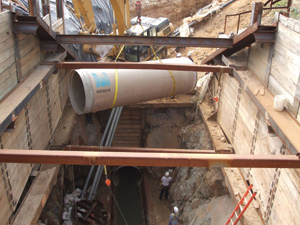Sliplining in Washington, D.C.
 In 1986, the United States Congress established The United States Institute of Peace (USIP) and has provided $100 million for construction of a permanent headquarters facility in Washington, D.C. It will be located at the northwest corner of the National Mall, facing the Lincoln Memorial and adjacent to the Korean War and Vietnam Veterans memorials.
In 1986, the United States Congress established The United States Institute of Peace (USIP) and has provided $100 million for construction of a permanent headquarters facility in Washington, D.C. It will be located at the northwest corner of the National Mall, facing the Lincoln Memorial and adjacent to the Korean War and Vietnam Veterans memorials.
Construction of the facility is scheduled for completion by the first quarter of 2010. However, there is a great deal of work to be done prior to groundbreaking. This includes shoring the existing infrastructure. The United States
Institute of Peace Sewer Rehabilitation Project will ensure structural integrity to the existing brick sewer that is located under the proposed building site.
Structural Requirements
The District of Columbia’s Water and Sewer Authority (DCWASA,) operates 1,800 miles of sewers and provides retail water and wastewater services to its customers in the district. DCWASA is charged with ensuring reliability of the area’s infrastructure. A brick sewer that was reportedly built in 1896 has been serving the area. Although it was in fair condition, with only a few repairs required in recent years along its entire length, planners decided that it needed permanent preservation to support future construction.
They also decided that slipline rehabilitation was necessary to ensure the sewer would not interfere with the future USIP facility. HOBAS centrifugally cast, fiberglass reinforced, polymer mortar (CCFRPM) pipe was the only product that met all of the project’s requirements. The new CCFRPM sewer is structurally sound, leak free and provides adequate capacity.
Randolph Rostas, senior project manager with the engineering firm Metcalf & Eddy (M&E), Washington, D.C., was the design engineer for the project. Project manager was Naveen Krishnamurthy from M&E’s office in Baltimore. Their engineers evaluated the existing site conditions, as well as the building proposals.
The approximate ground profile now exists 40 ft above the existing sewer. Depending on which of the final designs for the USIP building is adopted, the proposed lowest level of the slab could be just 5 ft above the existing sewer. Regardless of the final design, the pipe to be installed had to be structurally sound, grouted in place and capable of handling the final loads.
Preserving Capacity
The existing brick sewer was sliplined with 360 lf of 69-in. diameter HOBAS CCFRPM pipe. The actual inside diameter of the original brick sewer varied from location to location but was generally 73 to 75 in. M&E thoroughly evaluated the host pipe conditions in order to maximize the diameter of the sliplining pipe. The radial clearance calculated between the HOBAS pipe OD and the brick host pipe ID ranged between 0.25 and 1.25 in.
HOBAS CCFRPM’s efficient cross-section provides high strength with a thin wall. HOBAS also offers many pipe diameter choices for this type of application. Some pipe manufacturers offer only “standard” diameters while HOBAS has many “in between” sizes, such as the 69-in. nominal diameter utilized in this project. The tightest fit possible with the flush bell spigot pipe connectors also contributed to maximum flow recovery.
 General contractor for the USIP project, Clark Construction Group LLC, Bethesda, Md., brought Hall Contracting, Charlotte, N.C., onboard as the installation sub-contractor for the sliplining operation. Hall Contracting had utilized HOBAS on more than 10 past projects dating back to 1997. Hall Contracting CEO K. Michael Hall noted, “Hall tackles tough large diameter slipline projects and has used HOBAS pipe almost exclusively due to its toughness and ease of installation. This job was no exception.”
General contractor for the USIP project, Clark Construction Group LLC, Bethesda, Md., brought Hall Contracting, Charlotte, N.C., onboard as the installation sub-contractor for the sliplining operation. Hall Contracting had utilized HOBAS on more than 10 past projects dating back to 1997. Hall Contracting CEO K. Michael Hall noted, “Hall tackles tough large diameter slipline projects and has used HOBAS pipe almost exclusively due to its toughness and ease of installation. This job was no exception.”
The capacity of the existing sewer in the area that was relined ranged from 103 to 119 million gallons per day (mgd), while the capacity after rehabilitation was calculated to be 101 mgd. Flow monitoring after rehabilitation on previously installed HOBAS projects showed a Manning’s value of .009 to about .011. Manning’s values in this range are commonly utilized to predict capacity after sliplining. “On this particular project, we designed the sewer utilizing a predicted Manning’s value of 0.011 for the HOBAS pipe,” stated Rostas.
K. Michael Hall commented on the installation, “It appeared from our post-TV run that the flow depths had indeed been lowered by some 10 to 20 percent.”
Ease of Installation
“The sliplining went very well,” said Hall. “And after the pipe insertion, we grouted the annular space ourselves with a lightweight grout and this also went very well. The inspection ports revealed that the grouting filled the annulus completely.
“Three ports were installed at the 12 o’clock position spaced evenly along the 330-ft run. Upon inspection, the ports were solid with grout. We removed the valves and replaced the tapped holes with 1½-in. PVC plugs.” The plugs were provided by HOBAS.
With sewer work complete, the engineer and installer both said they were pleased with the performance of the pipe and the level of service provided by HOBAS.
Speaking for M&E, Rostas echoed Hall’s satisfaction with the project. “I had used HOBAS pipe in the past and I felt very comfortable with the product,” he said. “In this case, I recommended its use and we are pleased again with the outcome.”
Kimberly Paggioli, P.E., is marketing manager with HOBAS Pipe USA, which is based in Houston.
